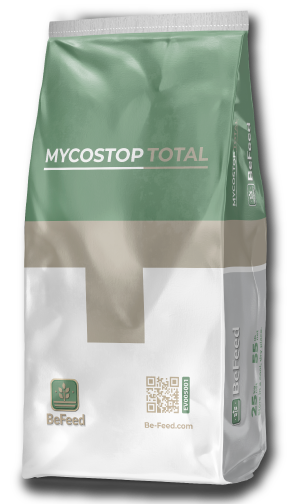Mycostop Total
Synergistic combination for increased mycotoxin adsorption + liver function

Mycotoxin adsorption plus liver function
A high-tech, multi-principle antimycotoxic additive (mineral adsorbent + yeast cell wall + hepatomodulator) that specifically acts as an adsorbent on mycotoxins, primarily aflatoxins, T2, deoxynivalenol (DON), zearalenone, and ochratoxin. Its combination with active ingredients that promote liver health makes it a dual tool for ensuring the care of the digestive system, improving its performance.
Mycotoxins
It eliminates mycotoxins from the intestinal lumen due to the high cation exchange capacity of its aluminosilicates (greater than 80 mEq/I).
Mycotoxins
It eliminates mycotoxins from possible absorption due to an adequate pore size in its aluminosilicates to sequester them (2.5 Å)
Immune response
It stimulates the intestinal immune response by greater activation of macrophages, which occurs thanks to its high proportion of Beta-Glucans.
Liver Function
Promotion of liver function at the exogenous and endogenous levels (hepatocyte regeneration)
Beta-Gucanos
The high concentration of Beta-Glucans (45%) in the selected yeast fraction allows a high adsorption capacity to mycotoxins
Broad-spectrum protection
against mycotoxins
Mycotoxins affect animal health, well-being, and performance, even at low and combined levels. Mycostop Total is a broad-spectrum technological feed additive formulated to provide more comprehensive protection against polar and nonpolar mycotoxins.
Its action combines high-capacity mineral adsorbents, enzymatic biotransformation agents, and protective extracts that support liver and antioxidant function. This ensures a higher level of feed safety, reducing the impact of mycotoxins on immunity, reproduction, and production efficiency.
Blog
No Results Found
The page you requested could not be found. Try refining your search, or use the navigation above to locate the post.






